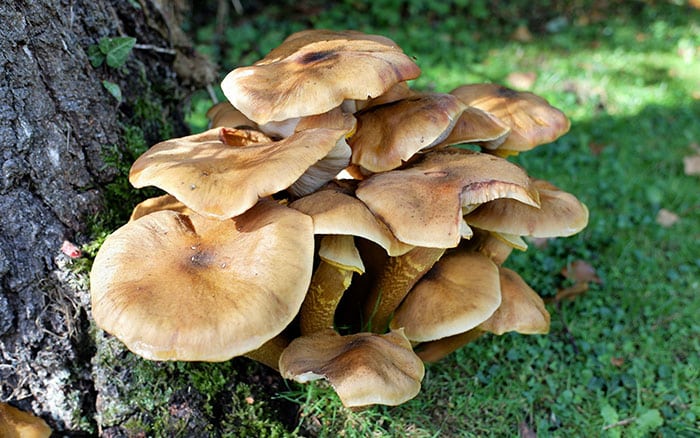Honey fungus is one of the most common root diseases in the world. There are seven different species of honey fungus found in the UK. Of which two are the most common, Armillaria mellea and A.gallica.
Armillarias are long-lived, the largest known cluster covering nearly four-square miles. This is the equivalent of over sixteen hundred football fields! And it is estimated to be around 2,400 years old.
What is honey fungus?
Honey fungus is an infectious root disease affecting trees and shrubs caused by several different species of the fungus Armillaria. A. mellea is the most damaging to certain types of trees and shrubs.
‘Mellea’ means ‘honey’ and this fungus gets its common name from the fruiting body mushrooms it produces being honey-coloured.
Examples of susceptible trees and shrubs are birch, ceanothus, privet, escallonia, forsythia, witch hazel and Virginia creeper. The Royal Horticultural Society has an extensive list:
https://www.rhs.org.uk/advice/pdfs/honey-fungus-host-list.pdf
How to spot honey fungus
The most distinguishable characteristic of honey fungus is the appearance of honey-coloured mushrooms on and around tree stumps. These emerge from late summer to autumn, but their appearance is usually brief.
Other times of the year look for the following symptoms:
- White fungal growth, usually at ground level, disappearing under the tree bark.
- Cracking and bleeding of bark at the base of the stem.
- Smaller, paler than normal-looking leaves.
- Branches on the upper parts of the tree or shrub dying; either suddenly, during drought, or gradually over a few years.
Many other different types of mushrooms and fungi will grow side by side with trees without damaging them. But honey fungus is a completely different matter.
It will grow around the base of a tree and kill all its living tissues as white strands spread up the tree, just under the bark. This has the effect of stopping the movement of water and nutrients up and down the tree or shrub.


How to control honey fungus
The best way to control honey fungus is to dig out the whole tree, shrub or plant. Remove as much of its roots as possible, as they will also be infected. Tree stumps must also be removed or ground out.
Once dug out all of it, including stumps and roots, must be either sent to landfill or burnt.
Don’t attempt to grow any trees or shrubs susceptible to this fungus in soil where previously affected plants have been removed. This is because it’s likely that spores will remain in the soil for a few years after removal.
Examples of plants less susceptible to honey fungus are:
- Bamboo
- Box hedge
- Callicarpa
- Catalpa
- Chaenomoles
- Chomonanthus
- Cordyline
- Erica
- Garrya
- Ginkgo
- Hypericum
- Jasmine
- Ornamental grasses
- Pittosporum
- Sarcococca
- Tamarix



Although there are several different types of Armillaria some are more deadly than others. So, it’s best to get specialist advice before taking action as it may be a type that’s less problematic than A. mellea.
If you need specialist advice, I would recommend you get in touch with your local garden centre for help.

Leave A Comment